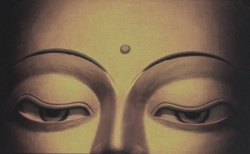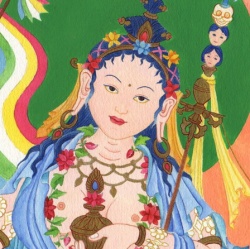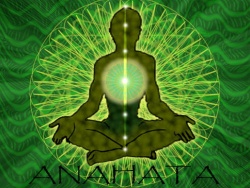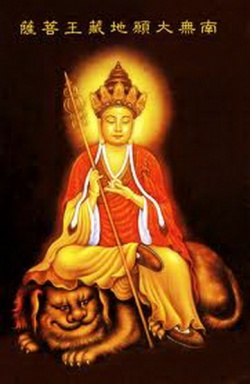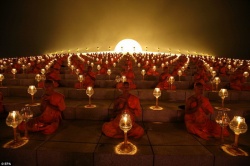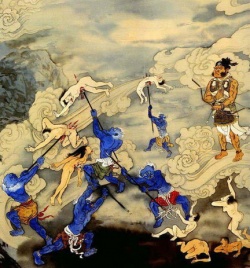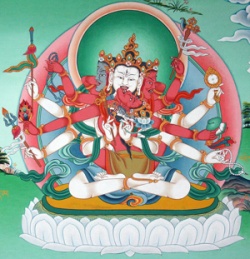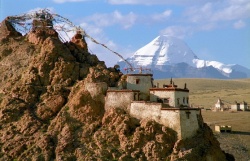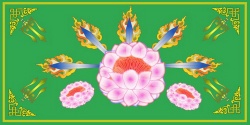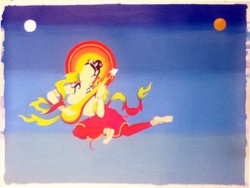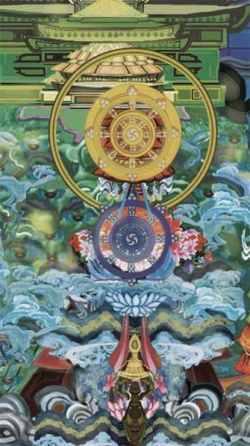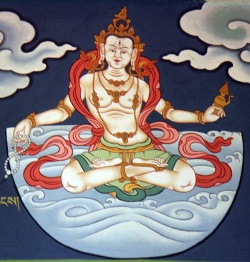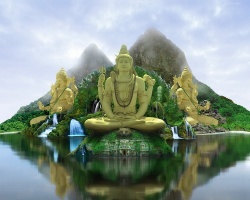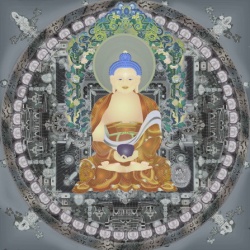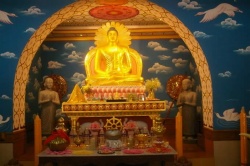The Modes of Transmission of Nyingma Teachings
According to Nyingma history, the three inner classes of tantra, Mahayoga, Anuyoga and Atiyoga, all derive ultimately from Samantabhadra, the primordial buddha-body of reality. They have been transmitted down to the present day in three distinctive phases: the lineage of the enlightened intention of the conquerors, the lineage of the symbolic gestures of the awareness holders, and the lineage of aural transmission through exalted individuals. Furthermore, there are two modes of transmission that are at work in Tibet: oral transmission, or Kama (bka’ ma) and revelation, or terma (gter ma).
The lineages of the three inner classes of tantra – Mahayoga, Anuyoga and Atiyoga – all derive ultimately from Samantabhadra – the primordial buddha-body of reality, the fundamental nature or actual reality of buddha-mind.
Manifesting in the realm of Great Akanistha, in the form of Vajradhara, endowed with all the signs and marks of buddhahood, Samantabhadra confers through the blessing of his enlightened intention, the realization of manifestly perfect buddhahood upon the five buddhas (Vairocana and so forth) who preside over the assembly of the hundred peaceful and wrathful deities, and who assume the buddha-body of perfect resource, inseparable from himself. This transmission is known as the lineage of the enlightened intention of the conquerors, and is therefore devoid of symbolic gestures or verbal expressions.
Simultaneously, in a special realm of Akanistha, the same blessing is conferred by the peaceful aspects of buddha-body of perfect resource – Vairocana and so forth – through symbolic gestures indicative of enlightened intention, upon the most exalted bodhisattvas – Vajrapani, Avalokiteshvara and Manjughosa, each of whom is responsible for communicating these teachings symbolically to their respective followers – yaksas, nagas and devas.
Meanwhile, in lesser realms of Akanistha the wrathful aspects of the buddha-body of perfect resource confer the same blessing through the imperishable sound of pure vibration upon harmful beings – Rudra, Bhairava and so forth; and, in a lower realm known as the Abode of the Thirty-three Gods (Trayatrimsha), the Buddha Vajrasattva bestowed the pith instructions of the Great Perfection upon his own emanation, Adhicitta, a divine being whose realization was also instantaneously born.
The first human recipient of this lineage is considered to have been the latter’s offspring – Prahevajra of Oddiyana, known in Tibetan as Garab Dorje (dga’ rab rdo rje).
In more conventional and terrestrial realms, such as Mt Malaya, Vajrapani then imparted the tantras symbolically to five exalted being, one of whom, Vimalkirti the Licchavi, was human. These transmissions, whereby the teachings of the buddha-body of perfect resource are conferred on the buddha-body of emanation, are collectively known as the lineages of the symbolic gestures of the awareness-holders, and are therefore devoid of verbal expressions.
The three classes of tantra were thereafter transmitted in the human world through lineages established by exalted individuals, and their respective texts gradually established. Among them, King Indrabhuti who had received the teachings from Vajrapani, and Vajrasattva transmitted the Mahayoga Tantras. His successor Kukkuraja divided them into eighteen books. The eight classes of sadhana based upon them fell to Humkara and so forth.
King Indrabhuti assumed the name Vyakaranavajra and, as such, he received the Anuyoga tantras from the aforementioned Vimalakirti, transmitting them in turn through Kambalapada, Prahevajra, Shakyaprabha (Prabhahasti), Shakyasimha (Padmasambhava), Dharanraksita, and Dharmabodhi.
The Atiyoga tantras are said to have been transmitted by Prahevajra through Manjushrmitra, who divided them into three classes, and Sri Simha who divided the pith instructions into four teaching-cycles. In this transmission the buddha-body of emanation confers the teachings upon human beings by word and letter. It is known as the lineage of the aural transmission through exalted persons. It continues down to the present day through an unbroken succession of oral teachings and spiritual revelations.
With regard to the class of spiritual revelations there are three additional modes of transmission that are considered to be orthodox. Among them, the lineage empowered by enlightened aspiration. This includes those treasure finders who discover their appropriate revelations on the basis of the former enlightened aspirations of Padmasambhava and Yeshe Tsogyal (ye shes mtsho rgyal) that the indicated individuals will emerge in the future to reveal their respective treasures.
The lineage of prophetically declared spiritual succession includes those treasure-finders whose actual names or circumstances have been prophesized in the writings of Padmasambhava. Finally, the lineage of the dakinis’ seal of entrustment includes those treasure-finders to whom the guardians of the treasures rightfully bequeath encoded texts, which they alone are able to interpret.
Kama Transmission
Nyingma Kama (rnying ma bka’ ma) literally means the Oral Lineage of the Ancient Ones. The term Kama in general refers to the Buddhist teachings that came through a long lineage from one master to another. Nyingma Kama specifically is a collection of teachings from the three inner tantras (nang brgyud sde gsum) that are considered to have been brought to Tibet from India and translated into Tibetan during the early translation period (8th and 9th centuries). Every major Nyingma master since the 8th century holds the Kama lineage.
These Kama teachings were transmitted through a long line of masters dating back to the Indian origins of Buddhism through the time when it was first brought to Tibet. It is said to be the very teachings that Padmasambhava and his disciples were actually practicing. Padmasambhava extracted the quintessence of these elaborated practices as a concise corpus of teachings that where then concealed as termas (gter ma), and revealed later for the sake of future generations.
The Kama is comprised of the teachings of the Trilogy of Sutra, Mayajala, and Citta. Within this structure, the Mayajala serves as the basis or tantra, the Sutra is the commentary or agrama (lung), and the Citta is the essential instruction.
The Mayajala teaching belongs to the Mahayoga. It is based on the philosophical view of the intrinsic purity of all appearances, as well as the equality of samsara and nirvana. It employs meditations on the mandalas of the One Hundred Peaceful and Wrathful Deities as explained in the Guhyagarbha Tantra.
The Sutra belongs to Anuyoga. It is based on the tantric scripture, the Samdhisamgraha Sutra, The Gonpa Dupa Do (dgongs pa ’dus pa mdo), which regards the meaning of all the Buddhist vehicles in the context of the view of Anuyoga. It is path has two aspects: the path of means which uses yogic exercises, and the path of liberation.
Citta refers to the instructions of the mind class of the Great Perfection. These teachings are concerned with sustaining the recognition of mind’s undeluded clarity, unstained by the confusion of samsara. This is a most profound path, through which many generations of meditators attained enlightenment. Some, like Vairochana’s octogenarian student, Mipam Gonpo (mi pham mgon po), even dissolved their bodies into light.
It is said of the Kama teachings that they “first fell to Nyak, then to Nub, and finally to Zur.” This means that they first were held and propagated by Nyak Janakumara (gnyags dznya na ku ma ra), next by Nub Sanggye Yeshe (gnubs sangs rgyas ye shes), and finally by the masters of the Zur lineage. Both Nyak Janakumara and Nub Sanggye Yeshe were direct disciples of Padmasambhava and Vimalamitra and are among the Twenty-five Disciples.
The Zur lineage began with Zur Shakya Jungne (zur po che shakya ’byung gnas), Zungchung Sherab Drakpa (zur chung shes rab ’byung gnas), and Zur Shakya Sengge (zur shakya seng ge). This lineage was well-known for its practice of Yangdag Heruka, and also established an important lineage of teaching the Sutra, Mayajala, and Citta Sections.
From these masters onward, the Kama teaching spread widely. The tradition of the Zur clan remained a hub of the Nyingma Kama teachings in Central Tibet. In eastern Tibet the Kama was preserved at the Katog monastery which was established by the great master Dampa Deshek (dam pa bde gshegs) in the 12th century.
Terma Transmission
Since the tenth century, Tibetan Buddhist traditions have recognized the discovery of concealed teachings – terma – as a profound and authentic form of transmission of the teachings. This mode of transmission is considered the “short” mode, as opposed to the “long” mode of the Kama, which has been transmitted person to person since the 8th century. Terma, in contrast, claims to be a direct transmission from Padmasambhava (or, less frequently, Vairocana or another 8th century master) and the treasure discover, bypassing the centuries in between.
The treasures are said to have been concealed by Padmasambhava to be discovered in the appropriate time. They are considered to be the condensed quintessence of the Kama, which contains the main teachings practiced at the time of Padmasambhava and upon which the termas are based.
According to the foundational legend, when Padmasambhava bestowed the ripening empowerments and liberating instructions upon the king Trisong Detsen (khri srong lde’u btsan), Yeshe Tsogyal and other of his twenty-five main disciples, he entrusted many teachings to each of them for later dissemination. With their assistance he then concealed these as treasures in various places – rocks, lake, temples, statues, and even in the sky and in the mindstream of the recipient. He then prophesied that, in the future, these disciples would reincarnate, reveal these teachings from their place of concealment and spread them for the sake of beings.
Those who reveal treasure are called tertons (gter ston). In due time, a terton is said to experience visions or signs indicating how and where to discover his or her destined terma. Often they experience a vision of a being who hands them an inventory of the treasures to be revealed, with the location.
A kind of treasure that is sometimes considered a third stream of transmission is dagnang (dag snang) or pure vision. As explained by Dilgo Khyentse Rinpoche, in pure visions the terton has a vision of Padmasambhava or another saint from the lineage who transmits the teaching. Two other primary methods of revelation, to be discussed below, are earth treasure (sa gter), which are physical objects revealed from actual places, and mind treasure (dgongs gter), which are extracted from the mind of the treasure revealer.
The terma teachings are considered powerful because they were not corrupted by the impurities that inevitably occurred in the history of lineages and are particularly relevant for the time of their prophesized discovery. That is, as direct transmissions from Padmasambhava or other Imperial-era saints, they did not suffer from scribal errors or innovations introduced by lineage holders over the centuries.
There are customarily three ways by which Padmasambhava set forth a teaching as a treasure:
1) By giving a prediction: Padmasambhava predicted that the benefit of these teachings for sentient beings will be accomplished by a certain disciple and that the terma will be revealed at a certain appropriate time, place, and circumstance.
2) By means of an empowerment through wishing prayers: While focusing his wisdom mind, Padmasambhava prayed that the teachings and pith instructions given at the time of bestowing the empowerment may fully and clearly arise in the mind of the disciple in the rebirth during which he or she is meant to reveal the treasure. The disciples also prayed in the same way. This is why almost all Nyingma termas were revealed by incarnations of directs disciples of Padmasambhava, the main ones being known as the “Twenty-five, The Lord and Subjects” or jebang nyernga (rje ’bangs nyer lnga).
3) By entrusting the dakinis to look after the terma: Padmasambhava put the dakinis in charge of ensuring that, in due time, the terton will find the treasure, will be able to transmit it to suitable disciples, and that his lineage will carry great blessings while being kept secret from unqualified disciples.
The terma teaching is said to have then been placed under the guardianship of a specific protector, referred to as a Terma Protector (gter srung), who will only allow the right person to be given access to the treasure. One some occasions, however, a terton may bless another realized master to extract the treasure in his place. This is how, for instance, Jedrung Trinle Jampa Jungne (rje drung phrin las byams pa ’byung gnas) of Riwoche (ri bo ches) asked the famed yogi Gara Lama (mgar ra bla ma), in front of a large crowd, to retrieve a terma on Amitayus, the Buddha of Infinite Life.
Out of these three aspects of the transmission, the wishing prayer of Padmasambhava is considered to be the most important, as it is the means by which the entire process unfolds. In fact, it is sometimes said that whichever form the terma is found, such as dakini symbolic scripts written on a yellow parchment (shog ser), this is said to be a mere support for remembering the time when the terton received the teachings from Padmasambhava. The real transmission is said to have been given from mind to mind given by Padmasambhava.
On the basis of this symbolic support, the terton with proper karma will thus be able to “establish” (brtan la ’bab) the whole teachings, sometimes in the flash of an instant, and put it in writing without any of the hesitations and discursive thinking that normally characterize ordinary literary compositions. It is said that the terton may see the whole text “as if looking into a mirror.” It is explained that the sight of the dakini scripts acts as a trigger so that the teachings arise effortlessly from the creative power of the vast expanse of pure awareness.
Some termas arise in ways that are clearly and beautifully written, complete and in perfect order, such as the Prayer in Seven Chapters revealed by Rigdzin Godemchen (rig ’dzin rgod ldem chen), some in a seemingly disordered and obscure style that requires it to be rearranged and clarified, for instance some of the termas revealed by Rigdzin Longsel Nyingpo (rig ’dzin klong gsal snying po). This is why, in addition to the root terma, a great master in the terton’s lineage usually needs to prepare a text which incorporates the terma teachings but is arranged in the form of a “means of accomplishment” or sadhana, or a ritual text that can readily be used by practitioners.
How Terma is Found
Over its more than one thousand year history the treasure tradition has standardized the narrative of treasure discovery. Although few histories of revelations follow the standards narrative, it is useful to survey in order to understand the many steps that the tradition claims as part of the treasure discovery process.
The first thing that is said to be found by the terton is the list or inventory (dkar chag or byang bu) of the treasures that he is meant to reveal during his life. This list is found, like other termas, in rocks, statues, and so on, or is given to the terton in a vision or in reality by Padmasambhava. He appears sometimes in the guise of a yogi, a monk or in any other form. It can also be given by one of the guardians of the teachings. Ratna Lingpa (rat+na gling pa) is said to be the only terton who found all the termas predicted in his inventory. This is why his teachings are said to carry particular blessings and efficacy.
In order for the terton to find the treasures listed in the inventory, many auspicious connections need to be gathered. Often one condition is that the terton meet a predestined spiritual consort through whom his or her spiritual channels will be untied, allowing the free flowing of the teachings through the terton’s wisdom mind. That is, the treasure tradition maintains that sexual yoga is necessary for the discovery of treasure, a claim that has earned the tradition considerable scorn by its (primarily ordained) detractors. This applies to both male and female tertons. There were, however, a few major tertons, such as Rigdzin Jatson Nyingpo (rig ’dzin ’ja’ tshon snying po) and Jamyang Khyentse Wangpo (’jam dbyangs mkhyen brtse’i dbang po) who were celibate and did not rely upon a spiritual consort to reveal their termas. However, Khyentse Wangpo bemoaned the fact that his treasures were only mind treasures and not earth treasures, which he considered superior.
Termas are said to be extracted from their place of concealment at the time when they are most needed and beneficial to sentient beings. Depending upon the circumstances, the quality of the auspicious connections, the purity of sacred bounds between teacher and disciple (samaya) and the merit of beings, the terma will be revealed more or less easily and will benefit a greater or a smaller number of people. When Dudjom Rinpoche (bdud ’joms rin po che), for example, was sitting in small room facing the entrance of Padmasambhava’s cave on the cliff of Paro Taksang (pa ro stag tshang) in Bhutan, the yellow scroll for his Vajrakilaya cycle of teachings came floating in the air through a small open window and landed in his lap. In some other cases, tertons are said to have toiled for days with axes and rods to reach the terma deeply embedded in the rock.
Normally, only the terton who was meant to find the terma is able to decipher the dakini script. Yet, according to Dilgo Khyentse Rinpoche, other tertons may get a general idea of the kind of treasure the scripts code is for, such as a guru sadhana or a Dzogchen teaching. Some exceptional tertons like Jamyang Khyentse Wangpo are said to be able to understand all forms of dakini scripts. Khyentse Wangpo once confided that, on one occasion, he had been able to see clearly the locations of all the termas hidden in Tibet and other places.
Such great tertons are also the ultimate reference to judge the authenticity of other termas. It is therefore customary for a terton to present his terma to such a master and ask him to confirm whether his discovery is genuine and will benefit beings, or whether it should be discarded. Dilgo Khyentse Rinpoche used to show his mind treasures to his teacher, Dzongsar Khyentse Chokyi Lodro (rdzong sar mkhyen brtse chos kyi blo gros). Chokyi Lodro not only validated the termas but requested Dilgo Khyentse Rinpoche to give him the transmission for them. Often treasure revealers are taken under the sponsorship of ordained lamas, granting them the legitimacy that celibate institutional hierarchy wield in Tibetan society.
The tradition allows for two or more tertons being entrusted with the same treasure discovering it either together or simultaneously in various places. This was often the case with the three great 19th century masters Jamyang Khyentse Wangpo, Jamgon Kongtrul and Choggyur Lingpa (mchog gyur gling pa). Once, Choggyur Lingpa came to show Khyentse Wangpo the treasure of the Sampa Lhundrup cycle (bsam pa lhun grub) that he had just revealed. Khyentse Wangpo not only confirmed the authenticity of the terma, but added that he had exactly the same treasure, almost word for word, and that there was not need for him to put him into writing, since Choggyur Lingpa had already done so. A similar process happened for Choggyur Lingpa’s Barche Kunsel (bar chad kun gsal) treasure; Khyentse Wangpo claimed to have also revealed it, but as mind treasure, whereas Choggyur Lingpa’s was earth treasure.
Having received the treasure inventory, the terton next follows it to the proper location where he needs to find and “open the door of the treasure” that often bears a distinctive mark. In there he usually finds a treasure box (gter sgrom) that often takes the aspect of a round brown jewel stone that contains the yellow scroll. He then has to put back something in place of the treasure (gter tshab) and again seal the place of concealment. This is done to placate the non-human entity who guards the treasure, a form of barter to prevent the guardian from feeling bereft. The act of revelation is either done alone or with assistance, and is sometimes performed before an audience of devotees in an event called a “public treasure” (khrom gter). The fifteenth century terton Pema Lingpa (pad+ma gling pa) was particularly famous of public treasures, and Choggyur Lingpa made a habit of the practice in the later part of his career.
As mentioned above, auspicious circumstances play a vital role in the revelation of termas. The story is told that once Padmasambhava appeared in person in front of Ratna Lingpa in the form of a yogi dressed in yellow raw silk. He showed him three scrolls, a white, a red and a blue one, and asked Ratna Lingpa to choose one of them. Ratna Lingpa answered that he wanted all three. Because of the auspicious connection created by his answer, Ratna Lingpa received all three inventories and revealed in a single life time the termas he would have otherwise revealed in three successive life times.
Seemingly insignificant events may also create various levels of auspicious links. Once, Dilgo Khyentse Rinpoche was requested at Neten Monastery (gnas bstan) in Nangchen to decipher a yellow scroll rediscovered by Choggyur Lingpa, which the latter had never put into writing. Khyentse Rinpoche put the scroll in a cup filled with sacred amrita substances and asked the monks to perform an elaborate ganachakra offering. At some point during the ceremony, he requested ink and paper and was brought about fifty white sheets, which he soon filled with his writings. When he handed the text over to the lama who had made the request he said: “There was three versions of the terma, a long elaborate one, a medium one and a condensed one. According to the amount of paper you gave me, I have put into writing the medium-sized one.” Thus, some tertons write out a terma briefly while some in its full length. An example of a complete length terma is the thirteen-volume terma of Sanggye Lingpa (sangs rgyas gling pa, the Lama Gongdu (bla ma dgongs ’dus).
In many cases, the terton keeps his discovery secret for many years, and practices the teachings they contain until achieving signs of accomplishment. He will then transmit it to a single disciple. Such first recipient of the teachings, who has generally been prophesized in the terma itself, becomes the holder of the teaching. Jatshon Nyingpo kept his Konchok Chidu Treasure (dkon mchog spyi ’dus) secret for over twenty years. Karma Lingpa (kar+ma gling pa) transmitted his treasure collection, known as the Karling Shitro (kar gling zhi khro) to a single disciple, after which it continued in a single-transmission line for seven until it was widely spread to many disciples.
Categories of Terma
Classifications of termas have been put forth by several proponents of the tradition over the centuries. Well-known classification scheme include those Guru Chowang (gu ru chos dbang), Jamgon Kongtrul, and the 1st Dodrubchen, Jigme Trinle Oser (’jigs med ’phrin las ’od zer).
1. Earth Treasures (sa gter). These are buried in rocks, statues, lakes, trees, and so on, usually in the form of a yellow scroll on which are written a few syllables in symbolic dakini script. These letters can only be deciphered by the terton to whom the legacy of the spiritual treasure belongs, and are unintelligible to anyone else. The scroll it often found within a treasure-box, that can be made of stone, jewel, etc. These scrolls were sometimes written down by Padmasambhava himself or, according to his instructions, by Yeshe Tsogyal, his main disciple and spiritual consort, or by other disciples such as Yeshe Yang (ye shes dbyang), Denma Tsemang (ldan ma rtse mang), Legchin Nyima (legs byin nyi ma) or Vairotsana. These earth treasures represent the main corpus of the terma tradition.
2. Mind treasures (dgongs gter). These were concealed by Padmasambhava in the mind-stream of the treasure revealer. They surge clearly in the terton’s mind at the appropriate time by the power of Padmasambhava prayers, with no physically manifested scroll or treasure.
3. Material treasures are objects such as statues of Padmasambhava or various deities, ritual implements (vajras or kilas), artifacts used and blessed by Padmasambhava or one of his twenty-five disciples, or sacred substances such as amrita, red and white bodhicitta, relics from Padmasambhava or others masters, and so forth.
4. Re-extracted treasures (yang gter). These have been found once by a terton who, for various reasons, considered that the time and circumstances were not yet proper for propagating them and concealed them again. Later, another terton, often a re-embodiment of the first one, reveals them a second time and propagates them.
5. Recollections (rjes dran). These are termas based on reminiscences of occasions when the terton was received teachings in a former life from Padmasambhava or others enlightened masters such as Vimalamitra.
In summary, there are seven transmissions or seven categories which cover all the existing modes of transmission:
Oral Lineage;
Earth Treasure;
Mind Treasure;
Re-extracted Treasure:
Recollection;
Pure Vision; and
Whispered Lineage.
The first one thus being the long lineage of the Kama and the latter six various forms of terma lineages
Groupings of Treasure Finders
According to the life stories of Padmasambhava revealed in particular by Urgyen Lingpa (o rgyan gling pa) and Sanggye Lingpa, Padmasambhava predicted the advent of 108 great tertons, a thousand medium ones, and countless minor ones. A great terton is defined by the later tradition as one who counts among his discoveries three major cycles known as “ladzogtuksum” (bla rdzogs thugs gsum): a cycle focused on Padmasambhava (the lama), one focused on Dzogchen and one on Mahakarunika, or Tukje Chenpo, another name for the patron deity of Tibet, Avalokiteshvara.
There are numerous groupings of the treasure revealers. The most common is the “Five Kingly Tertons” (gter ston rgyal po lnga) who were particularly eminent masters: Nyangral Nyima Oser (nyang ral nyi ma ’od zer), Guru Chokyi Wangchuk (gu ru chos kyi dbang phyug), Dorje Lingpa (rdo rje gling pa), Padma Lingpa (padma gling pa) and Jamyang Khyentse Wangpo.
Various texts enumerate “Eleven Stainless Lingpas” (dri ma gling pa bcu gcig) and Twelve Great Lingpas (gling chen bcu gnyis), among whom Rinchen Lingpa (rin chen gling pa), Karma Lingpa, Orgyen Lingpa (o rgyan gling pa), Sanggye Lingpa, Samten Lingpa (bsam gtan gling pa), Dorje Lingpa (rdo rje gling pa), Ratna Lingpa, Kunkyong Lingpa (kun skyong gling pa), Pema Lingpa, Ledro Lingpa (las ’gro gling pa), Tennyi Lingpa (bstan gnyis gling pa) and Shikpo Lingpa (zhig po gling pa). Another category lists “Eight Major Lingpas” and includes Sanggye Lingpa, Dorje Lingpa, Rinchen Lingpa, Pema Lingpa, Ratna Lingpa, Kunkyong Lingpa, Dongak Lingpa Nesar Khyentse Wangchuk (mdo sngag gling pa gnas gsar mkhyen brtse’i dbang phyug) and Tennyi Lingpa.
Authenticity of Terma
The terma transmission plays a vital role in the Nyingma tradition but it is also found in other lineages and even in ancient Buddhist India. The Great Fifth Dalai Lamag [[Lobzang[Gyatso]] (ngag dbang blo bzang rgya mtsho), was not only one of the most influential figures in the history of the Gelugpa tradition but was himself a terton, under the name of Dorje Thogme Tsel (rdo rje thogs med rtsal). He was also a disciple of the great Nyingma terma master Minling Terchen Terdag Lingpa (smin gling gter chen gter bdag gling pa). The Kagyu patriarch Marpa Lotsawa is said to have concealed treasures that were later revealed by Dungtso Repa (dung mtsho ras pa), and other Kagyu masters including the 15th Karmapa, Khakyab Dorje (kar+ma pa 15 mkha’ khyab rdo rje), have revealed terma teachings.
In a wider perspective, the phenomenon of treasure teaching is not uncommon in Buddhism, even in the sutra Mahayana tradition. One example is the most essential collection of Mahayana Buddhist scriptures known as the Prajnaparamita,The Transcendent Perfection of Wisdom, which the great Indian sage Nagarjuna retrieved from the subterranean realm of the nagas. The Five Dharmas of Maitreya which all schools study, were teachings of the Buddha Maitreya, received in visionary experience and put into writing by the great Indian pandita Asanga.
Nevertheless, considering the extraordinary nature of the terma tradition, it is not surprising that its authenticity has been put in doubt by Buddhist and non-Buddhist alike. It has often been dismissed as a fraud or as self-delusion. The whole process indeed flies in the face of materialistic views.
One may offer, however, a few counter-arguments.
Tertons have appeared throughout centuries in various places and circumstances. Among them were uneducated shepherds and learned scholars, kings as well as humble farmers, craftsmen, monks and yogis, men and women. Even though some tertons could hardly read and write, when the time came for them to put their termas into writing, they could spontaneously write volumes of the most profound teachings couched in deep and beautiful prose and poetry. Many of them were highly respected spiritual masters who displayed throughout their lives flawless ethical qualities. It would be hard to imagine that such a collection or remarkable beings could, in a mysterious way, conspire in various times and places, without knowing each other, to fabricate texts and teachings of such incredible depth and meaning.
As for self-deception, the contemplative teachings certainly warns practitioners about the deceptive nature of fleeting meditative experiences and give detailed indication to distinguish genuine spiritual accomplishment from mere hallucinations. In any case, self-deception cannot account for the discovery of material termas made in public and involving miraculous feats witnessed by all.
One of the most famous examples is that of the great Bhutanese terton Pema Lingpa. He faced widespread criticism, especially from the local rulers, for being a fraud. On one occasion, the ruler of Chokor valley in Bumthang stroke with a sword a statue of the Buddha that Pema Lingpa had discovered saying that it has been fabricated by the terton who happened to be a skilful blacksmith (this statue can still be seen today, with the mark left by the sword on its shoulder.) It happened that Pema Lingpa was meant to reveal another treasure in a forested a place where a stream rushes in between two small cliffs and opens up in a tiny lake which then became known as Mebarsto, the Burning Lake, after the miraculous events related here by Lopon Pema, one of the most learned contemporary Bhutanese scholars, who was himself born in Bumthang:
“When the time came for Pema Lingpa’s next discovery, the word spread and a large crowd of people was assembled by the governor of Chokhor, Thupa, on the rock above the river. Thupa said to Pema Lingpa: “If you can reveal this treasure, I shall reward you, but if not, you shall be punished for bringing this treachery to my district.” So the saint found himself under great pressure from the governor and the local people to prove himself. Standing on the Naring Drak rock above the swirling waters, he called aloud to the Guru Padmasambhava: “If I am a genuine revealer of your treasures, then may I return with it now, with my lamp still burning, if I am some devil, then may I perish in the water!” And now with this prayer, holding the lighted resin lamp in his hand, he leaped into the lake.
Some of the crowd said to themselves that he had jumped into the river in shame; others said to his father that now his son was surely drowned. His parents began weeping. Thupa too was shocked and ashamed at the role he had played. He said to Pema Lingpa's parents: “It is my fault, I shall make full amends to you.”
But even as he said this, the figure of Pema Lingpa emerged from the water below, the lamp still burning in one hand and in the other, a statue the size of a fist and a treasure casket of joined skulls, and, as if borne up on wings, he was standing beside them on the rock again.
After this incident, the people’s doubts about him were dispelled, he gained many followers and his renown began to spread far beyond Bumthang throughout Tibet.” (drawn from Padma Tshewang, Khenpo Phuntsok Tashi, Chris Butter, and Sigmund Saetreng, “The Treasure Revealer of Bhutan: Pema lingpa, the Terma Tradition and Its Critics,” Bibliotheca Himalayica, ser. 3, vol. 8., Kathmandu, Nepal: EMR Publishing House, 1995.)
This narrative is taken from a text that actively promoted Pema Lingpa’s lineage, and one must be careful not to confuse it with history. However, it gives insight into how the tradition responded to criticism over the centuries: by creating narratives in which many witnesses, including highly placed figures such as kings, were convinced of the authenticity of the treasures.
The Treasury of Terma
A great number of lineages have emerged based on the many different terma teachings. In the mid-1850s Jamgon Kongtrul collected many of these in his Treasury of Terma ([[rin chen gter mdzod), an extraordinary collection of more than sixty volumes which contains hundreds treasure texts with related liturgical manuals necessary to bestow the empowerments and explanations to practice them.
Jamyang Khyentse Wangpo traveled for thirteen years throughout Tibet in order to receive transmissions for the many lineages that had become very rare and were held by only one or very few people. He also experienced a number of visionary meetings with historical holders of lineages that had been cut, thereby reviving them. The redaction and editing of the Treasury was done by Jamgon Kongtrul at the monastery-hermitage of Dzongsho Deshek Dupa (rdzong shod bde gshegs ’dus pa), a secluded mountain retreat located between Dzongsar and Katok.
The Treasury of Terma was the second of Jamgon Kongtrul’s so-called “Five Treasuries.” It is a collection of root sadhana and other liturgical manuals, many of which Kongtrul wrote himself, relating to treasure revelations of well over one hundred different treasure revealers. The main section is arranged according to the traditional composition of a complete cycle of Nyingma tantric liturgy: the Guru sadhana, arranged by inner, outer, and secret Padmasambhava practices; the tutelary deity (yi dam) section, arranged by the categories of the Kabgye (bka’ brgyad: the traditional eight tutelary deities of the Nyingma school: Yamantaka, Hayagriva, Shriheruka, Vajramrta, Vajrakila, Matarah, Dmod pa drag sngags and ’Jig rten mchod bstod) and the dakini / dharmapala section. These, the original core of the work, totaled some sixty-three volumes, to which an additional forty-seven volumes of ritual liturgies were amended by Dilgo Khyentse in the late 1970s to total one hundred eleven volumes.
Jamgon Kongtrul began work on the Treasury, a project that would occupy him for over thirty years, in the spring of 1855, not long after completing the Kagyu Ngagdzod (bka’ brgyud sngags mdzod). Kongtrul recorded in his autobiography that he had thought of the project during the summer of 1855, and that he had received Jamyang Khyentse’s approval and suggestions:
“I had thought that if there were a text which gathered all the many important old minor treasure that I had received over the years it would go some distance towards being of benefit to their transmission, and I mustered the effort [to undertake the project]. In addition to those, I thought it would be good if the collection of the received empowerments of the rare and uncommon dharma treasures of the major illustrious treasure revealers included minor treasures as well, since they too have efficacious, if minor, practices. I put this to my all-seeing master Mkhyen brtse’i dbang po; he said, “Write about four volumes collecting the minor treasure; it would be very good if, using those as a basis, it were to be written according to the texts of the complete Guru sadhana, Dzogchen, and Avalokiteshvara practices of the great terton, in accordance with your aspirations.”
Jamgon Kongtrul conferred with Jamyang Khyentse and which treasure cycles warranted inclusion. This was not an easy decision, nor one without controversy. Elsewhere in his autobiography he recorded that he had appealed to the highest authority in the matter: Padmasambhava himself. In 1857 he requested his colleague, Choggyur Lingpa (mchog gyur gling pa) to ask Padmasambhava for approval when Choggyur Lingpa next met with the Guru, and received an enthusiastic affirmation. Kongtrul wrote:
“While I was in the process of endeavoring to collect important treasures, I requested Choggyur Lingpa to examine thoroughly which would be suitable [for inclusion]. Several inventories and treasure caskets had come to him recently, and he said, ‘Such times, when I meet Guru Rinpoche in person, would be the perfect opportunity to ask him [such] questions; I will not forget [his responses] and will keep them [in my memory).’ On the way to Jadra (ja sbra; the site of Choggyur Lingpa’s next revelation) he stopped at Padrag (dpa’ brag) and performed a feast offering. There he received the supplementary inventory for Sengdrak (seng brag; a latter site of he revelations). On the first day of the new fire serpent year [February 25, 1857], having received the brief list of the twenty-five great sites, Choggyur Lingpa came here and we made offerings to the lords of the treasure. When I asked about his investigations [on the matter of which treasures to include] he [told me that] he had put the question to Guru Rinpoche and [received] many lines of verse in response. However, at that time I wrote down only some fragments. The main gist appeared to be that I had received an edict that based on the force of my karmic propensity and aspirations, I was permitted to include whatever I wished.”
The most controversial exclusion from the collection was the treasures of the well-known if somewhat notorious seventeenth century treasure revealer Rigdzin Nyima Dragpa (rig ’dzin nyi ma grags pa). A lama to both the royalty of Lhasa and Dege, Nyima Dragpa, a notorious magician, had fallen afoul with the Karma Kagyu treasure revealer Yongge Mingyur Dorje Dragpo Nudentsal (yongs dge mi ’gyur rdo rje drag po nus ldan rtsal), and was blamed for the death of the 10th Karmapa Choying Dorje (kar+ma pa 10 chos dbying rdo rje). His teachings were henceforth essentially blacklisted from Karma Kagyu circles, and thus were not included in the Treasury.
Kongtrul’s addition of several Bon liturgies elicited the strongest opposition. In the early twentieth century a Nyingma lama named Gyarong Tendzin Dragpa (rgya rong bstan ’dzin grags pa), apparently angry over the exclusion of the treasures of Nyima Dragpa, made the accusation that the work was corrupted by the Bonpo inclusion. Jamgon Kongrul’s disciple, Chogtrul Pema Wangchen (mchog sprul padma dbang chen) requested some of the most illustrious masters of the day to compose responses: the 15th Karmapa, the 11th Situ Pema Wangchok Gyalpo (dpal spung si tu 11 padma dbang mchog rgyal po), and Ju Mipam Gyatso (’ju mi pham rgya mtsho). Mipam declined, apparently believing that Tendzin Dragpa’s accusation did not warrant the attention, and in his stead his disciple Shechen Gyaltsab Pema Wanggyal (zhe chen rgyal tshab padma rnam rgyal) composed a response.
Although capitulating to some degree to institutional pressures, Kongtrul was otherwise quite active in making sure he had the materials he desired to include, even pressuring treasure revealers to finish their revelations in time to make the collection. For example, Kongrul relates an episode from 1863 in which he pressured Choggyur Lingpa to “decipher” a sadhana from a 1957 revelation at Sengdrag that included a treasure cycle and a hagiography of Padmasambhava entitled the Garland of Jewels, which is not extant. Choggyur Lingpa deciphered one section, the Heart Essence of Vajrasattva, and, telling Kongtrul that “he had supplicated O rgyan Rinpoche for the transmission and empowerment for this and had received an omen that he had been given them,” he gave him the transmission. With the text and its transmission in hand, Kongtrul was able to insert it into the Vajrasattva section of the Treasury (vol. 42).
The working title of the collection was the “Garland of Treasures” (gter spreng). Already in summer of 1856 Kongtrul had completed some ten volumes, which he had edited and proofed, of a work that, he wrote, did not yet deserve the name “treasury”. The impetus for the name change came with a prophetic dream Jamyang Khyentse had in 1861, in which he saw that Kongtrul would need to compose what would be known as the five treasuries; he told Kongtrul that he should therefore call the collection of treasures he was working on by the name Treasury of Terma. Kongtrul reports assigning the name the following year, in 1862.
Wooden-blocks were then carved at Palpung (dpal spung) Monastery in a 60-volume edition. From this edition, another set of wooden-blocks was carved at Tsurphu (mtshur phu) Monastery with three additional volumes.During his life, Dilgo Khyentse Rinpoche gave the transmission of the Rinchen Terdzo five times, and had the collection reprinted in India in a 70 volume edition that included the four volumes written by the 15th Karmapa, Khakhyab Dorje that are indispensable for giving the numerous empowerments (around 1700) included in the Treasury, and a few other volumes that, according to the indications given by Jamgon Kongtrul, should have been added to the original collection. (The division of the same collection in 111 volumes, which is recorded in the Library of Congress, was made for other practical reasons).
Authors: Mathieu Ricard, Jakob Leschly, Ron Garry, Gyurme Dorje, Alexander Gardner
